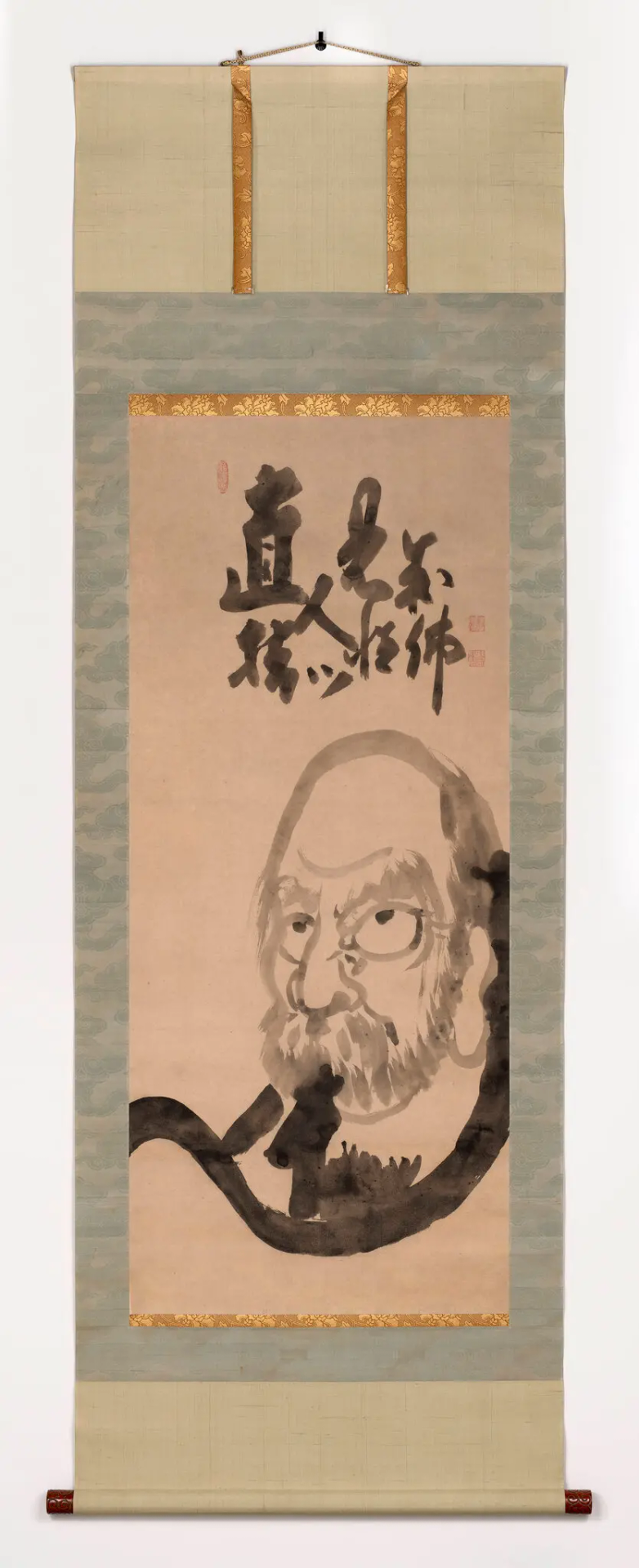#Ekaku Hakuin
Explore tagged Tumblr posts
Text

Ekaku Hakuin (1685-1768)
Hamaguri-kan’non
Here, the Kan’non Goddess of Mercy, who has appeared from inside a hamaguri clam, is preaching to creatures of the sea, including the Dragon King, fish and clams. The Hamaguri-kan’non is one of the 33 Kan’non. Only the clam and the Kan’non are usually depicted. The inclusion of the Kan’non’s audience is an original concept of Hakuin. It is based on the essence of the Kan’non-gyo Sutra contained within the Lotus Sutra in which the Kan’non appears in a form appropriate to her audience to save the various living beings of this world. The words of praise are derived from a passage from the Kan’non-gyo Sutra and mean “With compassionate eyes, she looks at all living beings, and good fortune gathers, boundless like the sea.” The work is believed to have been painted when Hakuin was in his early 70s.
白隠慧鶴(1685~1768)
蛤蜊観音図 はまぐりかんのんず
蛤蜊から出現した観音が、龍王をはじめ魚や貝など海の生きものたちに説法している。蛤蜊観音は三十三観音の一つで、通常は蛤蜊と観音のみを描くが、このような聴衆を描き込むのは白隠の創作��ある。観音がこの世のさまざまな衆生のために、その衆生に応じた姿となって現れ救済するという『法華経』普門品の主旨に基づいている。賛の「慈眼視衆生、福壽海無量」も同経の一節に由来するが、「聚」字を「壽」字に変えている。白隠70代前半の作と推定される。
14 notes
·
View notes
Text

🎨✦
1 note
·
View note
Text
"Two hands clap and there is a sound; what is the sound of one hand?"
-Koan, attributed to Hakuin Ekaku, 1686 - 1768
23 notes
·
View notes
Text
Not knowing how near the truth is, we seek it far away." Hakuin Ekaku
12 notes
·
View notes
Text

"Two longtime painters recently told me how joyful their studio practices had become in their 40s once they took their minds off their ambitions, stopped trying to impress anyone, and just let the paintings paint themselves. I’ve been dabbling with working that way myself, so I was thrilled to find the memorable demonstrations of unburdened artistic spontaneity that are scattered in 'None Whatsoever: Zen Paintings from the Gitter-Yelen Collection' at the Japan Society."
-- Zen Paintings at the Japan Society.
4 notes
·
View notes
Text
Not knowing how near the truth is, we seek it far away. - Hakuin Ekaku
2 notes
·
View notes
Text

When you understand that form is the form of the formless, your coming and going takes place nowhere else but where you are.
— Hakuin Ekaku
art: Tomás Sánchez
30 notes
·
View notes
Text
Today's apocryphal Sun Tzu quote
Doubling down is a sure sign of distress.

Hakuin Ekaku - Calligraphy about anger. Japan, about 1745, AD.
23 notes
·
View notes
Text

Non sapendo com'è vicina la verità, la cerchiamo lontano: è come se fossimo immersi nell'acqua e implorassimo da bere. Hakuin Ekaku ********************* Not knowing how close the truth is, we seek it far away: it is as if we were immersed in water and begging for a drink. Hakuin Ekaku
5 notes
·
View notes
Text

Lost on dark paths of ignorance, we wander through the Six Worlds, from dark path to dark path - when shall we be freed from birth and death?
~ Hakuin Ekaku
迷失在無明的暗道上,我们遊蕩於六趣中,從暗道至暗道——我們何時方可從生與死中解脫?
~ 白隱慧鶴禪師
3 notes
·
View notes
Video
youtube
Zen at its best-Story of Zen master Hakuin Ekaku’s-Is that so
0 notes
Text



Cercava applausi
Da chi non ha due mani,
Si irritava.
Di una sola mano
Ora ascolta il suono ?
BaoUtnaFèretWaka, 21 settembre 2024 - 10.21, Kontowood.
Hakuin Ekaku Zenji (1685-1768) è una delle più grandi figure del Buddhismo giapponese.
Maestro zen, pittore e calligrafo, fu il primo a creare e organizzare il sistema basato sulla pratica del KOUAN. Il suo preferito è:
« Quando si battono entrambe le mani si produce un suono; qual è il suono di una sola mano che batte? »
#baotzebao#valerio fiandra#haikyou#kontowood#ilrestomanca#ildopovita#baoutnafèretwaka#KOAN#mani#applausi#suono#ascolto
0 notes
Text
The Zen of Falling Short
Hakuin Ekaku’s masterpiece, “Giant Daruma,” 18th century, which depicts the glowering visage of the Indian monk remembered in Japan as the founding patriarch of what became Zen, wears its Zen ideas lightly. Credit… The Gitter-Yelen Collection. [New York Times caption and illustration] The thin, gray quality of the old man’s face suggest [sic] that even a Zen master’s identity is evanescent,…

View On WordPress
0 notes
Text
It's like chopping down a huge tree of immense girth. You won't accomplish it with one swing of your axe. If you keep chopping away at it, though, and do not let up, eventually, whether it wants to or not. it will suddenly topple down.
ZEN MASTER HAKUIN EKAKU
0 notes
Link
0 notes
Photo

Turn a photo to a work of art in a click.
Tool used: aiTransformer Stylizer: Daruma in Red, Hakuin Ekaku; Intensity 40%, applied area: foreground
0 notes